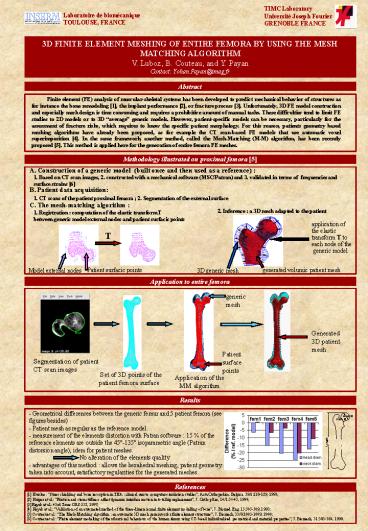POSTER MICCAI98 - PowerPoint PPT Presentation
Title:
POSTER MICCAI98
Description:
Finite element (FE) analysis of muscular-skeletal systems has been developed to ... 45 -135 isoparametric angle (Patran distorsion angle), idem for patient meshes. ... – PowerPoint PPT presentation
Number of Views:52
Avg rating:3.0/5.0
Title: POSTER MICCAI98
1
TIMC Laboratory Université Joseph Fourier
GRENOBLE FRANCE
Laboratoire de biomécanique TOULOUSE, FRANCE
3D FINITE ELEMENT MESHING OF ENTIRE FEMORA BY
USING THE MESH MATCHING ALGORITHM V. Luboz, B.
Couteau, and Y. Payan Contact Yohan.Payan_at_imag.fr
Abstract
Finite element (FE) analysis of
muscular-skeletal systems has been developed to
predict mechanical behavior of structures as for
instance the bone remodeling 1, the implant
performance 2, or fracture process 3.
Unfortunately, 3D FE model construction and
especially mesh design is time consuming and
requires a prohibitive amount of manual tasks.
These difficulties tend to limit FE studies to 2D
models or to 3D average generic models.
However, patient-specific models can be
necessary, particularly for the assessment of
fracture risks, which requires to know the
specific patient morphology. For this reason,
patients geometry based meshing algorithms have
already been proposed, as for example the CT
scan-based FE models that use automatic voxel
superimposition 4. In the same framework,
another method, called the Mesh-Matching (M-M)
algorithm, has been recently proposed 5. This
method is applied here for the generation of
entire femora FE meshes.
Methodology illustrated on proximal femora 5
A. Construction of a generic model (built once
and then used as a reference)
1. Based on CT scan images, 2. constructed with a
mechanical software (MSC/Patran) and 3. validated
in terms of frequencies and surface strains 6
B. Patient data acquisition
1. CT scans of the patient proximal femora 2.
Segmentation of the external surface
C. The mesh-matching algorithm
2. Inference a 3D mesh adapted to the patient
1. Registration computation of the elastic
transform T between generic model external nodes
and patient surfacic points
application of the elastic transform T to each
node of the generic model
T
Model external nodes
Patient surfacic points
generated volumic patient mesh
3D generic mesh
Application to entire femora
generic mesh
Generated 3D patient mesh
Patient surface points
Segmentation of patient CT scan images
Set of 3D points of the patient femora surface
Application of the MM algorithm
Results
- Geometrical differences between the generic
femur and 5 patient femora (see figures
besides) - Patient mesh as regular as the
reference model. - measurement of the elements
distortion with Patran software 15 of the
reference elements are outside the 45-135
isoparametric angle (Patran distorsion angle),
idem for patient meshes. No alteration of the
elements quality - advantages of this method
allows the hexahedral meshing, patient geometry
taken into account, satisfactory regularities for
the generated meshes.
References
1 Huiskes Stress shielding and bone
resorption in THA clinical versus
computer-simulation studies, Acta Orthopedica.
Belgica, 59/1118-129, 1993 2 Kuiper et al.
Friction and stem stiffness affect dynamic
interface motion in total hip replacement, J.
Orthop Res, 14/136-43, 1996 3Keyak et al.
43rd Trans ORS332, 1997 4 Keyak et al.
Validation of an automated method of the
three-dimensionnal finite element modelling of
bone, J. Biomed Eng, 15505-509, 1993 5
Couteau et al. The Mesh-Matching algorithm an
automatic 3D mesh generator for finite element
structures, J. Biomech, 33/81005-1009,
2000 6 Couteau et al. Finite element
modelling of the vibrational behaviour of the
human femur using CT-based individualised
geometrical and material properties, J. Biomech,
31383-386, 1998.































